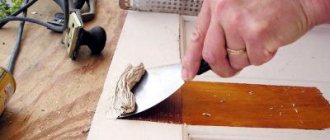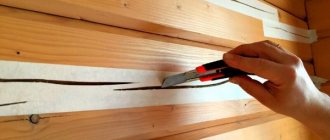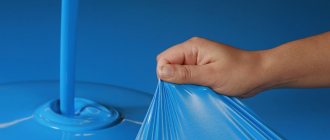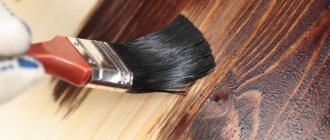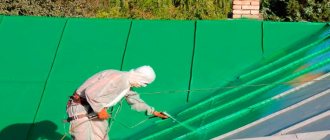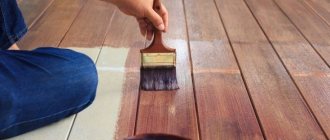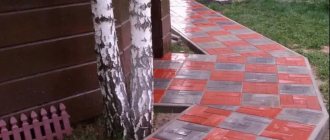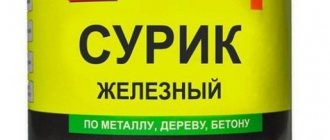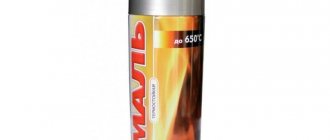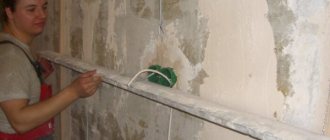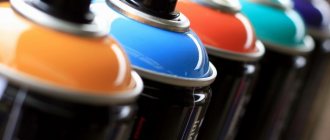Natural factors do not spare any building materials. However, the most difficult thing is for wooden structures - atmospheric or sedimentary moisture quickly renders them unusable. Impregnations that provide moisture-repellent properties to the material last only 3-5 years. After this, the effect of moisture on wood gradually becomes more and more destructive.
The material loses its attractive appearance and gradually begins to rot, losing its mechanical qualities. As a result, damaged structures or cladding have to be replaced even though they have not yet reached their normal service life.
Most often, paint is used to protect wood. There are many varieties, but most of them are not able to provide proper protection - they quickly peel off and become covered with cracks.
However, there are stable and durable types of coatings. These include rubber paint, which has the most balanced set of qualities.
What is rubber paint
The name “rubber paint” usually means latex material with a polymer content of at least 50%. At the same time, the material is made in the form of an aqueous dispersion, which improves the coating capabilities - eliminates shrinkage, ensures the absence of a strong chemical odor and speeds up drying.
In addition to latex, the paint contains a coalescent (a temporary solvent that ensures the liquid state of particles in the dispersion and participates in the process of film formation). There are also tinting compounds and other additives that ensure the strength and durability of the coating.
Externally, rubber paint resembles ordinary paintwork with increased viscosity. It is not recommended to dilute it to normal working viscosity, since this will cause the coating film to lose its strength and tightness.
The material is universal and can be used on different surfaces. High adhesion and resistance to external influences have made rubber paint the preferred coating on various materials and surfaces.
What is it used for?
The main purpose of rubber paint is to create a protective coating that cuts off atmospheric or sedimentary moisture from wood or other materials.
Decorative qualities are considered here secondarily, although the material may include any coloring compositions. They give the paint a stable color that remains regardless of climatic conditions or direct sunlight.
Expert opinion
Torsunov Pavel Maksimovich
To protect wood, rubber paint is one of the best options. Unlike conventional protective coatings based on drying oil or mineral (synthetic) oils, rubber paint is vapor permeable and does not clog moisture in the mass.
This ensures that wooden surfaces do not come into contact with water, but does not prevent the material from releasing excess moisture and increasing its working life.
In addition to painting wood, rubber paint is used in other areas:
repair of roofing coverings;
painting external walls, both with wooden paneling and plastered or brick;
waterproofing the pool bowl, bathroom or other wet areas;
protective painting of automotive equipment;
use for road markings;
application of anti-slip coatings on playgrounds, hospital buildings and other specific premises.
Rubber paint has universal properties - most varieties can be used for exterior and interior work. In addition, the material dries quickly - at a temperature of 20°C it takes only 2 hours to dry. This allows you to handle painting in a short time - as a rule, at least 2 layers are applied.
Manufacturers
Rubber paint and varnish material is produced by different companies - domestic and foreign, the choice is very large (can be found on any website, for example, kraski.ru). Typically, foreign paints and varnishes cost an order of magnitude more, although their properties are practically the same.
In first place in terms of sales is the paint Super Decor Rubber (Super Decor Rubber) VD-AK-103, which is produced in Russia by the company Balticolor. Super Decor is suitable for interior and exterior use, suitable for a swimming pool as it is highly moisture resistant. Superdecor can be used for slate to improve its aesthetic properties.
Other popular coatings with similar characteristics:
- Dali (Dali) - antifungal, perfectly masks cracks, evens out;
- Tikkurila (Tikkurila) - a high-quality line of latex-based products in a variety of colors;
- MasterGood (Master Good) - fits well on the base, creates a strong layer, and is an inexpensive alternative to tiles;
- Optimist F310 - is used as a sealant, waterproofing for roofs and facades;
- Plasty Dip - liquid rubber in cans, widely used for painting car bodies;
- Prosvet - the brand produces VD-AK-103 paint, which is characterized by high hiding power and elasticity;
- Farbex (Farbex) - universal paint, suitable for wood, OSB, metal, slate, tiles, galvanized, ondulin, plastic, aluminum;
- Maxima (Maxima) - ideal paint for concrete, the finished coating will be elastic and moisture resistant;
- Prom Color (Promkolor) - used for all types of roofing, for swimming pools, paving slabs, recommended for wet rooms, dries in an hour;
- Ecoross is an excellent paint for concrete floors, used in parking lots, garages, warehouses;
- Chief technologist from Novbytkhim - suitable for any surface, even with plaster, gives a smooth, beautiful coating;
- Elast-R is the best option for seismically active zones, for repair work in houses before they shrink;
- Siltex Paint - the best wear-resistant paint, semi-matte material based on water and latex;
- Matte is a car paint that gives a glossy layer to which midges and dirt do not stick.
Among the rubber paints, it is worth mentioning the brands produced in Russia: Pautinka, Snezhinka, Petra, Zima, Lakra, Technoprok. All of them are adapted for winter climates, so they will be an excellent choice in any weather conditions.
Advantages and disadvantages
The advantages of rubber paint include:
- high hiding power and adhesion to various materials;
- resistance to external influences (weather, solar radiation, temperature changes);
- high vapor permeability, providing the ability to release moisture from the protected surfaces;
- forms a matte non-slip coating;
- high hardening speed;
- ease of application and cleaning in case of accidental contact with hands or skin;
- the paint film has high strength and elasticity, which ensures resistance to changes in size or deformation of the base;
- does not contain toxic or aggressive components;
- guaranteed service life - 10 years.
Disadvantages of rubber paint:
- the dried coating feels more like rubber to the touch and does not have high hardness, which does not allow grinding and polishing the coating;
- When applying, it is necessary to strictly follow the manufacturer's recommendations, otherwise the properties of the coating will differ from the user's expectations. In particular, you cannot apply more than 4 layers - the coating will begin to peel off due to excess film stress;
- the price of paint is quite high.
Despite its shortcomings, rubber paint is highly rated by experts. They consider it a very promising material, capable of protecting wood from all external threats, as well as having an attractive appearance.
Areas of application
What to paint? The areas of use of rubber paint are varied:
- Facade works. Rubber dye is purchased to update the appearance of buildings, structures, and foundations. Great for concrete, brick, stone, wood. The cladding looks beautiful, and this cost item will not be large.
- Fences, house fences. You can paint any fences inside the site and around the perimeter with the product.
- Roofs. Using liquid rubber, roofs made of ondulin, slate, rubber slate, and galvanized steel are improved. The service life of the products will increase, and asbestos dust from certain types of bases will no longer be released into the air. Metal roofs will be reliably protected from corrosion and will not fade.
- Pools, walls and bottom of reservoirs. As a waterproofing material, rubber coloring is ideal for cladding such objects.
- Bathrooms, kitchens. The paint fully complies with safety requirements, is moisture resistant and not subject to friction.
- Children's rooms and entertainment facilities. The absence of toxic components makes the paintwork material suitable for use for these purposes.
- Paving slabs. If you paint the paths with the material, the surface will stop slipping, which is important when it rains. The tile will not lose its attractive appearance for many years.
- Baths, saunas. Lack of toxicity, non-destruction, moisture resistance - properties that are useful when using paint on these objects.
Rubber paint can be used on sports facilities, outbuildings, gazebos, terraces, and benches. The material will easily update the appearance of old furniture and worn-out interior items.
Varieties
Rubber paint is a new material that has not yet gained sufficient popularity. Therefore, it does not yet have a large number of varieties and a widely branched classification.
Basically, the material is distinguished by color and manufacturer. In addition, the material is distinguished by the type of surface - for wood, metal, concrete, etc. At the same time, the composition and performance qualities of rubber paint practically do not differ. The main difference may be the degree of viscosity.
In addition, you can divide the paint by release form:
in cans (aerosols)
liquid in jars (buckets)
under the spray gun
The greatest demand is for paints in cans or buckets. They are designed to be applied by brush or roller, which is the optimal way to apply a fairly thick layer. If you apply paint with a spray gun, you will either have to create many layers, or risk the tightness and reliability of the coating.
Among the rubber paint manufacturers, the following companies should be highlighted:
"Mizar"
A company from St. Petersburg, specializing in the production of special coatings at the request of the State Defense Order. The paint from this manufacturer has an affordable price - compared to some alternative options, its cost is 4 times lower. In addition, the composition of the material allows it to be used sparingly when applied - 150 g is used per 1 m2 (for other manufacturers - up to 450 g/m2);
"Technoprok"
Moscow company specializing in the production of waterproofing since 2004. Coatings based on liquid rubber are the company's calling card. It was she who was the first in Russia to introduce rubber roofing paint of her own production to the attention of buyers;
"ProTsvet"
Another company from Moscow, whose specialization is the production of rubber paint. The production cycle uses natural latex, which has the disadvantage that fungus can live on it. To protect wooden surfaces, this material can only be used if the base has been pre-impregnated with antifungal agents;
"NovBytKhim"
This company from St. Petersburg produces a wide range of household chemicals. Rubber paint occupies only a small part of the total production volume. It has been produced since 2008, and over the past time the company’s employees have been able to develop the technology and obtain a completely stable product. The paint is affordable, but the quality cannot yet be called elite;
"Super Decor"
This is a subsidiary of Balticolor LLC, a Russian manufacturer with a base in Khimki near Moscow. The paint has a balanced set of qualities, allowing it to provide reliable protection of wood from external influences;
"Ecoroom"
A Moscow company that produces various household chemical products. Ecoroom rubber paint has a large number of color options and can reliably protect wooden surfaces from moisture.
The number of color options for rubber paint is very large. They are tinted according to RAL and NCS standards, which allows you to accurately select a specific color and get the expected color without unpleasant mistakes and “surprises”.
Paint consumption and surface care
Liquid rubber is quite economical. Consumption will depend on the type of base. For example, iron or galvanization “consume” 250 g of paint per square meter. Concrete, brick, plaster use up to 400 g of product, wood - 350 g. Consumption for painting slate is higher - 450 g, for application to previously painted substrates - 150 g.
You can begin wet cleaning of the surface 7 days after the paint has completely dried. During this period, the paintwork material will acquire all the necessary properties. It is better not to use chemicals, but a soap solution will not harm. Purification in the future is carried out as needed.
Application methods
Rubber paint is a rather thick material with a high consumption. On average, a two-layer wood coating takes 350 g/m2.
Since the paint can be diluted by no more than 5%, it is impossible to ensure normal working viscosity for the spray gun without violating the manufacturers' recommendations. Typically, airless spray is used or hand tools are used. This results in higher operating speeds and material savings.
Rubber paint is applied to wooden surfaces according to the usual method of performing multi-layer coatings:
Preparation . Cleaning the surface of old paint, sealing cracks and cracks, sanding if necessary;
applying the first layer . Use hand tools (brushes or rollers), or sprayers (aerosols or spray guns);
allowing the layer to dry completely . It takes time; the package usually indicates a minimum period. It cannot be shortened, as the moisture from the paint will not have time to escape and will be trapped. It will be easier for it to absorb into the wood, which can create conditions for rotting or swelling;
applying subsequent layers with mandatory exposure of each of them.
You cannot lay a layer of paint that is too thick - most manufacturers limit its size to 4 mm. This is an important point, since the coating will be very expensive and unreliable - due to the large weight and internal stresses, the paint layer may peel off.
Another important point: the minimum air temperature must be at least +5 °C. In addition, the weather must be calm and dry. It is recommended to choose days that are not too sunny - under the scorching rays the paint sets too quickly. The surface film quickly gains density and does not allow moisture to escape from the applied layer, which increases the interlayer holding time.
Application order
Floor painting is divided into several successive stages:
- The floor surface is being prepared for finishing. Remove old paint mechanically or manually. You can use a metal spatula. If the old paint sticks tightly, you should use a drill with a special attachment. Grease stains are removed with a solvent.
- The wood surface is being sanded. A smooth surface is created.
- The floor is cleaned of dust remaining after sanding and primed.
- When the primer is completely dry, the first coat of paint is applied. For dyeing, it is best to use a fur roller with strong short pile. It is not recommended to use a foam roller. There may be streaks and stains.
- After 2-3 hours, the first layer is completely dry. After this, the paint is applied a second time.
Pay attention to: Types, features, similarities and differences of latex and acrylic paints for painting.
It is recommended to maintain a time interval of 1.5-2 hours between painting for the first and second time. If the paint is difficult to work with because it is too thick, you can dilute it a little with water. It takes approximately 3 hours for the floors to dry completely at above-zero temperatures. In low temperatures it is better to wait a day.
Questions and answers
Rubber paint is a new and unfamiliar material for many users. Some questions that inevitably arise during selection or use should be addressed in advance. This will allow you to avoid mistakes and get the best result.
When can you use rubber paint?
Application conditions require a temperature of at least +5 °C. This means that working with the material outdoors is only possible in the warm season. At the same time, you need to make sure that there is no strong wind or rain, otherwise the coating and material will be damaged. It is also undesirable to expose the freshly applied layer to direct sunlight. It is recommended to use a protective camouflage net when working on a hot summer day.
How thin can rubber paint be?
The standard ratio of solvent (water) to volume of material is 5%. However, for an inexperienced person this value means nothing. Moreover, the initial state of the material differs from different manufacturers - some paints are very thick, others are more liquid. Therefore, it is recommended to follow the usual criteria - the consistency of the paint should resemble liquid sour cream.
When can I wash or treat a painted surface?
As a rule, the first treatment with an antiseptic or washing the surface is carried out no earlier than a week after applying the last layer. At the same time, most users perform all types of processing before applying paint. The finished layer is usually washed in the spring, when the snow has melted and dust and layers of dirt remain on the surface.
Which application method is better?
If the surface allows, it is more convenient and economical to use a roller. Brushes are used in hard-to-reach places. Spraying outdoors is not the best option as too much material will become foggy and blown away by the wind. In addition, the material has to be diluted too thinly under the spray gun, which disrupts the crystallization regime and does not provide the expected film strength.
Is it possible to paint raw wood?
First of all, you need to distinguish between damp and wet wood. If it was recently cut down and has not had time to dry, it should not be painted under any circumstances. It is necessary to wait until the material dries, and only then can finishing be carried out. If the surface is wet (moistened with rain or melt moisture), just wipe it with a dry cloth and wait until it dries (usually 1-2 hours is enough).
How to care for the coating?
No special measures are required. It is quite enough to periodically wash the painted surfaces with warm water and soap (if possible), or at least spray with water from a hose. At the same time, it is necessary to take into account the specifics of the surfaces - if it is clapboard cladding (or wooden siding), you need to make sure that water does not get on the back side of the panels.
